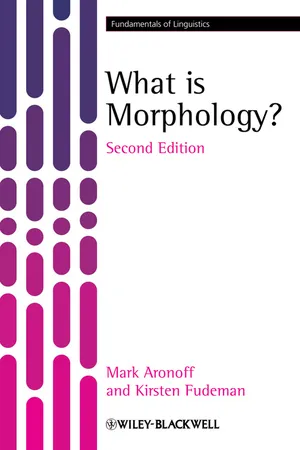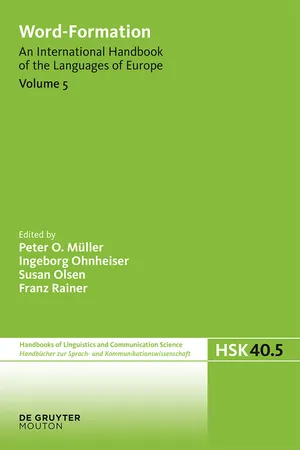Languages & Linguistics
Derivation
Derivation refers to the process of forming new words by adding affixes, such as prefixes or suffixes, to a base or root word. This process often changes the grammatical category or meaning of the original word. In linguistics, derivation plays a crucial role in word formation and expanding the vocabulary of a language.
Written by Perlego with AI-assistance
Related key terms
5 Key excerpts on "Derivation"
- eBook - ePub
- José Ignacio Hualde, Antxon Olarrea, Erin O'Rourke(Authors)
- 2012(Publication Date)
- Wiley-Blackwell(Publisher)
11
Derivation and Compounding
SOLEDAD VARELA1 Derivation: types, suffixation, prefixation
1.1 Types of Derivation
In the word-formation process known as Derivation, we can distinguish between: (a) affixal Derivation in which there is addition of affixes to a lexeme (in-constante ‘inconstant,’ transporta-ble ‘transportable’); and (b) nonaffixal Derivation or back-formation based on the elimination of some morphological part of the lexeme (retén ‘stop, checkpoint’ from retener ‘to retain’). Akin to this second procedure are the so-called thematic or postverbal forms in which a verb lexeme is converted into a noun just by adding an unstressed vowel to the root. This final vowel may coincide with the theme vowel of the verb, as in guard-a-r ‘to guard’ > guard-a ‘guard,’ although most times the derived noun shows up with a different vowel: atrac-a-r ‘to attack’ > atrac-o ‘robbery’; empuj-a-r ‘to push’ > empuj-e ‘pressure.’ In some cases the same verbal root admits any of the three vowels: costar ‘to cost’ > cost-e , cost-o , cost-a (s ) ‘cost.’1 In all Spanish dialects, word formation by means of affixation is prevalent.1.2 Suffixation: categorial and semantic selection
Lexical Derivation through suffixation is the most productive, general, and varied of Spanish word-formation procedures. Spanish has a large number of suffixes with variable meanings, and all the main lexical categories (V, N, A) accept this type of Derivation. Moreover, resource-to-suffixation is common to all language varieties – technical and scientific, legal and administrative, as well as literary – and to all registers or levels of formality, and suffixed words appear pervasively both in speech and writing.In the suffixation process, the “word marker” of the base noun is always suppressed. Word markers are morphological segments which are specifically associated with nominal Derivation. They are formed mainly by one of the three vowels a, o, e (esponj (a ) ‘sponge’ > esponj-oso ‘spongy,’ cor (o ) ‘choir’ > cor-al ‘choral,’ cond (e ) ‘count’ > cond-ado ‘county’), marginally also by the vowels i and u (tax (i ) > tax-ista ‘taxi-driver,’ trib (u ) ‘tribe’ > trib-al ‘tribal’), and by some complex endings formed by any vowel + s: (mecen (as ) > mecen-azgo ‘patronage,’ Carl (os ) ‘Charles’ > carl-ista ‘Carlist,’ diabet (es ) > diabet-ico ‘diabetic,’ tes (is ) ‘thesis’ > tes-ina ‘minor thesis,’ vir (us ) > vír-ico - eBook - ePub
- Karl A. Schmidt(Author)
- 2012(Publication Date)
- Dover Publications(Publisher)
WORD DerivationAlong with the mastery of the etymological relationships and word compounding, the understanding of German prefixes, suffixes and other word building elements is the quickest and surest way of expanding the students’ vocabulary methodically. The process of combining independent words, or their stems, with prefixes and suffixes which have no independent existence as words is called word Derivation.“Käufer ”(buyer, purchaser) is a derivative formed by adding the suffix -er to “kauf ” (the stem of “kaufen ”).“Kauf ”(purchase), the capitalized verb stem, is another noun derived from “kaufen ”.“käuflich ”(purchasable) is an adjective formed by adding the formative element -lich to the stem.The prefix ver - alters the meaning of the verb “kaufen” and its derivatives in a certain predictable way, which results in four more new words:When a student has mastered all the affixes and a basic vocabulary of about a thousand words,he can by means of exercises developed in the text acquire several thousand words with ease. In even rich languages like German with hundreds of thousands of words, the number of word-roots is relatively small. To know all the words of a language is clearly impossible ; to know most of its roots as well as all its prefixes and suffixes is possible.I. FORMATION OF WORDS THROUGH SUFFIXES AND DERIVATIVE ALTERATIONS.1. Infinitives Used As NounsMany German infinitives can be used as nouns to express the act of carrying out the action of the verb. Such nouns are usually equivalent to English gerunds. They are always neuter. - eBook - ePub
The Vocabulary of Modern French
Origins, Structure and Function
- Hilary Wise(Author)
- 2003(Publication Date)
- Routledge(Publisher)
9 .More recent approaches have tended to take individual morphemes as the basic input to the lexicon; each morpheme is given separately, with its phonological form, word class (in the case of roots), and semantic interpretation. A set of word formation rules then specify which affixes may be added to which roots (e.g. that the prefix dé- can only be added to a root marked as a verb). Then follows a set of phonological rules, of the type indicated on p. ; the final output represents the actual spoken form of the derived word, together with its meaning. Linguists differ in how they handle each of these stages in the generation of words. The phonological form of the morphemes entered in the lexicon may be more or less ‘abstract’—i.e. removed from the surface pronunciation of the morpheme; the more ‘abstract’ the base form, the more complex will be the later phonological rules. Two alternative forms of a morpheme may be entered together (e.g. the ‘learned’ and ‘popular’ allomorphs), with no attempt to derive one from the other; the word formation rules simply specify which allomorph is to be selected for which affix. Corbin inclines to the latter approach, giving for example the two forms of the root boeuf~bov-in separately, while Schane (1968 and 1973) sets up one underlying abstract form from which both can be derived. Some linguists choose to limit the scope of the word formation rules, to generate only words actually used by native speakers, while others (like Zwanenburg and Corbin) are not bound by this constraint, and allow the generation of all ‘potential’ words in the language. Zwanenburg does however build in a ‘blocking’ mechanism to rule out potential synonyms like *gloriosité - eBook - ePub
- Mark Aronoff, Kirsten Fudeman(Authors)
- 2011(Publication Date)
- Wiley-Blackwell(Publisher)
I’m going to mailbox this parcel ). (We say more about blocking in section 8.3.5.)4.2.3 AffixationThe next type of Derivational process we consider here is affixation. We have already looked at a number of affixes, so in this section we focus on a few particular affixes, the types of stems they attach to, and the words they produce. We also build on the discussion of primary and secondary affixes (chapter 3) by exploring other restrictions on combinations of affixes.Recall from section 1.2 that affixation may involve prefixes, suffixes, infixes, and perhaps circumfixes. Since our primary focus in this section is on English, we deal only with the first two types, although as you can see in the following box, English does have a productive infixing process that incorporates swearwords.We can characterize the stem an affix attaches to as bound or free and as belonging to a particular lexical category. Take the following words formed via prefixation with re -:(11)a. reignite d. reanalyze b. reboot e. recertify c. reread f. rebuild Re - attaches to stems belonging to the lexical category Verb. It produces words that are also verbs. All of the stems to which it attaches in the preceding examples are free. Ignite , boot , read , analyze , certify , and build may all stand alone; they do not need to bear a prefix or suffix. The same cannot be said for all stems that seem to bear the prefix re -, based on their meaning. The following words are all formed with re - eBook - ePub
- Peter O. Müller, Ingeborg Ohnheiser, Susan Olsen, Franz Rainer(Authors)
- 2016(Publication Date)
- De Gruyter Mouton(Publisher)
Greek Derivation is realized either as prefixation or suffixation. Compared to prefixation, suffixation displays more variability. While prefixes are usually transparent to the properties of the base, most suffixes can be category-changing, and transmit their features to derivative formations. As such, they are heads of their structures.With respect to their origin, affixes may be divided into three categories: a) affixes which originate from Ancient Greek and are still in use (e.g., -osini in a deadjectival noun like kalosíni ‘goodness’ ← kal(ós) ‘good’ + -osini ); b) affixes which are the product of grammaticalization, i.e. those deriving from other affixes or words (e.g., the prefix kse- which results from the combination of the Ancient Greek preposition ek - with the verbal syllabic augment e - (e.g., kseperno ‘to surmount, overcome’ ← kse- + pernó ‘to pass’, Ralli 2004); c) affixes which are borrowed from other languages. Among those of the third category, one finds examples originating from Italian (e.g., the verbal suffix -ar(o) ← Italian -are , as in voltáro ‘to stroll’ ← vólt(a) ‘stroll’ + -ar(o) ), Turkish (e.g., the nominal suffix -dzi(s) ← Turkish -cI , in nouns denoting profession, as in xalvadzís ‘halva seller’ ← xalvá(s) ‘halva’ + -dzi(s) ), and Slavic (e.g., the diminutive suffix -itsa which forms feminine nouns from feminine bases, as in δaskalítsa ‘little female teacher’ ← δaskál(a) ‘female teacher’ + -itsa ).Finally, as is usually the case for all word-formation processes, there are different degrees of productivity, depending on the process and on the type of the affix involved (Bauer 2001). For example, diminution (e.g., kukláki ‘little doll’ ← kúkl(a) ‘doll’ + -aki ) is subject to fewer constraints, and thus more productive, than the formation of deverbal nouns (see section 4.2 ). Furthermore, within the same process, certain Derivational affixes are more productively used than others of the same type. Consider the suffix -iz(o) , which creates verbs out of nominal bases (e.g., alatízo ‘to salt’ ← alát(i) ‘salt’ + -iz(o) ): its productivity prevails over that of the also denominal suffix -en(o) (e.g., anaséno ‘to breathe’ ← anás(a) ‘breath’ + -en(o)
Learn about this page
Index pages curate the most relevant extracts from our library of academic textbooks. They’ve been created using an in-house natural language model (NLM), each adding context and meaning to key research topics.




